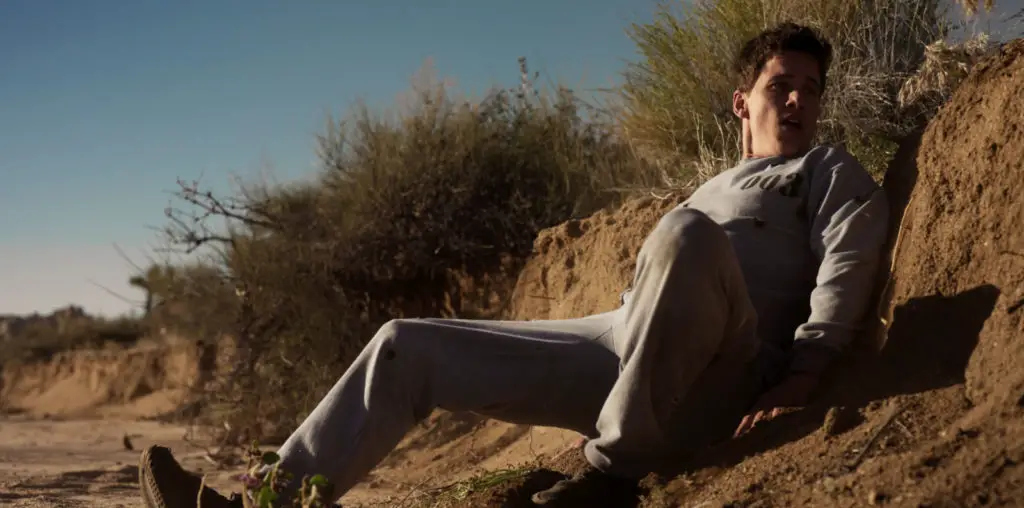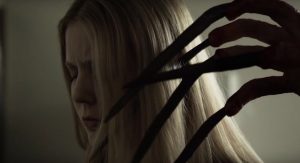
James Di Martino’s feature-length debut The Faceless Man is an Australian horror film that delves into what it means to be a survivor. Emily (Sophie Thurling) is a cancer survivor, and she survived a broken family, but she lives in constant fear of getting sick again. To help set her mind at ease, she joins a group of friends on a weekend getaway. At the house, they are confronted by a mobster who wants his missing drugs, a slightly delusional leader of a biker gang, and the horrifying titular creature. This tests Emily’s zest for life to the absolute extreme. Di Martino takes me through the production history of one of the most original movies of the year.
The Faceless Man is one of the most startlingly original, and insane, films I have seen all year. So, what was the genesis of the movie? Was it always intended to a hodgepodge of genres, or did that evolve during the writing process?
Thanks for picking up its originality. It was always intended to be an original work, one that borrowed from many genres. It always started as a drama, went into a drug-fuelled party, turned into a mystery, then comedy before venturing into horror themes. Essentially I wanted it to feel like a cancer that spreads and put people on a wild trip of emotions.
The writing process for this film was very complicated. There was so much going on, and having so many characters has its pros and cons. A lot of ideas in the script had to be simplified or even dropped. In one version the origins of the Faceless Man was revealed, but I hated it and decided to be metaphorical with my approach, which helped the tone and overall feel of the film. I pay homage to a lot of other movies but twist them in my own way. I used Wolf Creek and Evil Dead as key referencing points in regards to setting up the film. It takes 40 or so minutes for the big bad to appear in Wolf Creek, that first half really helps set up the characters. I did try to mimic that feel for when the horror happens.
Which leads me nicely to my next question.Given Australia’s long, proud, (and underrated) cinematic history, what were some of your biggest influences; both in terms of directing and writing?
As mentioned before, Wolf Creek by Greg Mclean was a big starting point for me; I did want John Jarret in this. Jennifer Kent’s The Babadook also really inspired me. Brian Trenchard-Smith’s Ozploitation work such as The Man From Hong Kong and Turkey Shoot are simply fantastic. I was very happy when Brian saw The Faceless Man and gave us the quote “The New Face of Ozploitation.” Mad Max is a clear inspiration and I adore the series for its wild display of the insane. As for writing, I feel I borrowed more from Tarantino than many Australian titles. It’s funny as Ozploitation films inspired Tarantino. So that I ended up using him as a reference point is of great pride.
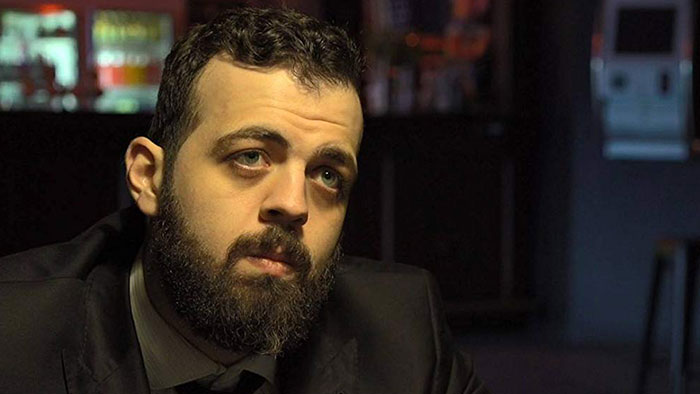
“…wanted it to feel like a cancer that spreads and put people on a wild trip of emotions.”
How was trying to pitch this movie to producers?
The reaction was mixed. There was one person that read the script and said it just didn’t work for today’s society, it is not politically correct and it has a character called Barry The C***. I saw that as a positive as horror is not meant to be politically correct, and Barry is one of my favorite characters, so he was not going to get cut. Other people liked it but wanted scenes cut or liked it, but didn’t get it. Anything original, new, or even if it breaks the rules doesn’t register with some people. Even when audiences watch the film and say they liked it. I feel they missed the point of the movie. Then again, even popular films face this. I settled on producing myself with my business partner Daniel Facciolo (who played Brad) and Rhys Sherring (who DOP and edited the film).
Were any of the producers you approached keen on the movie but wary of the marketing of such a hard to pin down tale?
Well in truth I had to dismiss one producer late into production because they had just vanished for six months and came back when the film was completed. It is sad when this happens because a kind of riff is created, and many people don’t understand why that decision was made. That person worked on the film while we were filming, they did little to nothing when we needed funds to complete the movie or even help with distribution. A lot of producers ride on the success or work of others, and I saw that happening and was not going to let that happen to my film. I also did a lot of the marketing for the film, in terms of booking cinemas and creating the website, the merchandise and assembling a marketing team to help promote the movie for its Australian release.
The first shot of the film is a long tracking shot following a man down the corridors of a hospital. Then he sits down and begins a conversation with the main character. This unbroken shot lasts for quite some time. What was the thought process behind this introduction?
It was always intended to open the film; which meant it was imperative to me that it was one long shot. It was very hard to get, and we got it on take seven, which was the last one we had time for the day. The long-shot is something I love playing with and used throughout the film as it sets a clear tone and cinematic style for the film. Also, it’s a film with many characters. We need to spend a certain amount of time with Emily to establish her as the lead, and this, in my opinion, was the best way to do so. The hardest part was to make it cinematic as two people sitting for some time can get boring. Thus the camera pans around almost like we are observing these two people and a sphere is created. We are in their world for the next nine minutes. It also sets a very dark tone for the film, and I feel it’s why the comedy works with the horror so well. It has been established this is a dark story from its opening moments.
The character of Viktor Nov is introduced at home with his family. While his wife scolds him for never wanting to see her family, his daughter is destroying toys. It is both horrific and hilarious. How did you direct the young actress to bring out as much enthusiasm as possible for this small, but memorable moment?
Viktor needed something to stand out. He needed to be likable as he’s a menacing murderer, lacking mercy. He is the big bad antagonist until we see even worse. Thus it was important to create a moment of love for his daughter. She is a mirror of him, just younger. He loves her more than his wife, and she is oblivious to his sadistic nature. It is also a nice parallel to Emily, who always wanted that love from her father. Viktor here gives his daughter that love but is a killer. It’s a contradiction I like to play with. Viktor’s daughter is played by Ellie Tevelis and is the real-life daughter of Maria Tevelis, who portrays Viktor’s wife. She comes from a good acting background, and I was able to spend a nice amount of time with her and get her motivated to learn Russian for the part and get her in the mood of a lovable daughter. She took direction very well and never questioned what I had to say.
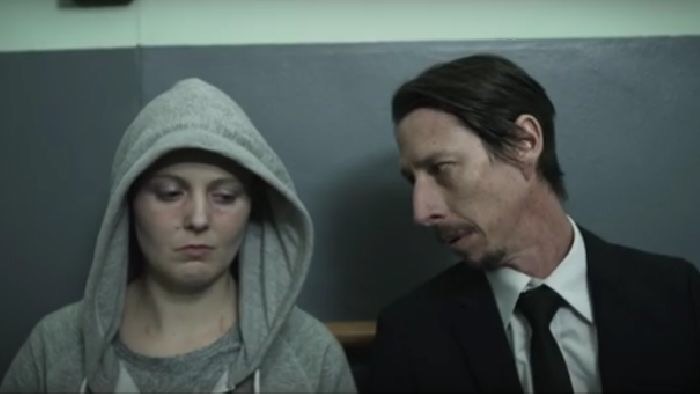
“…a nice parallel to Emily, who always wanted that love from her father.”
The Orange Lodge is an integral location to the story. Was that a set or a real house? What challenges were offered by that location, and how did you and your team overcome them?
Orange Lodge is actually the name of the town they visited. But I guess it’s a nice fit to the central location of the house. It’s a real house created from the ground up by two very special people. I came across the house via AirBNB. They had a lot of it decorated, but it was a testament to the art department that did a lot of work in setting it up. A lot of the doors in the house were unique, but the main one (for story purposes) needed to be built, and that’s thanks to the Production designer who got it made. Other than that the house was a great location we didn’t have to do too much to it and the owners were great, having even provided catering. The biggest challenge by far was keeping my sanity over a 16-day shooting period where each day was a huge 12-14 hour filming day. We didn’t have money or time to come back, so we had to ensure everything was done in that time. I would never advise anyone to do that ever. It is crazy (and I guess made the film that way haha).
Were there any scenes rewritten due to budgetary issues or to clarify something?
There was a sex scene that had to be scrapped. This provided a problem and actually yielded a better scene in the gold mask dance sequence. Sometimes when working on films with a lot going on it can get hard to keep up with all the story points. I know that sounds s**t, but on small teams, it can happen. But I learned that when things don’t work, it provides an opportunity to improve the story. This can lead to more problems in the cast not understanding why these changes happen and start to question their motives, but it’s the director’s job to ensure it all cuts together and works.
Throughout the film, the sound design is crucial to the proper mix of tones and genuinely delivering the frights once the horror ramps up. What conversations did you and the sound team have to ensure the visuals and audio were on the same page?
Sound for The Faceless Man took a total of six months. It was a long process and one that almost shut down the film. We were very low on funds and needed a good score. I was very lucky to find Bart Walus, who just understood the film and created this score that brought the movie to a new standard. I had a lot of reference tracks to give Bart, and he always took the notes I gave him and improved them. Through Bart, I met Benni Knop who mixed the film. With a good score, a good mix is needed. Benni spent hours chipping away, creating layers on layers of sound for the Faceless Monster effects. It needed to be unique and loud. I wanted it very loud for people to really take in. Both of them were always on the same page as me, which helped a lot and proved to be one of the most enjoyable parts of making the film.
The whole cast nails it, but the person audience members outside of Australia are most familiar with is Roger Ward. How did you manage to get such an icon in the film?
Roger is someone I really wanted to work with on this. John Jarret was my original choice for King Dougie, but he couldn’t do it. Roger was interested in the role and I feel it just worked out better. I was able to rewrite Dougie to fit Roger and make him standout. Roger was always a big supporter of the script. He was one of the few who really had faith in it from day one. I respected that, and I learned a lot from working with him on this. We didn’t get him for long, but we had Roger for 3 days and had to make sure we got everything within that time (it was hard as we had a faceless man scene to do that day so make up had to spend hours for that one-shot). Roger really did make King Dougie his own and provided a lot of screen presence that his 40+ year career had given him. I think many will like his portrayal of that memorable character.
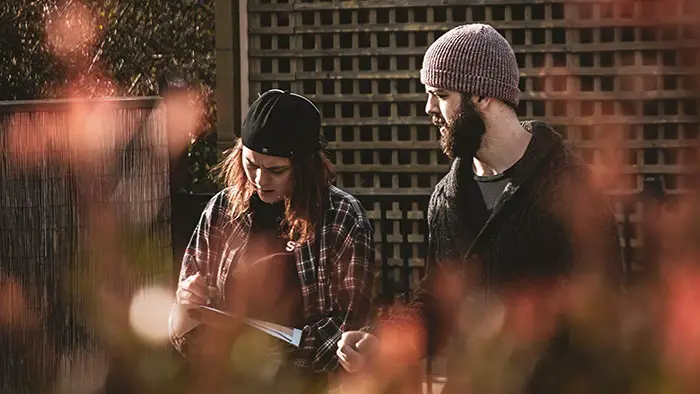
“One big scene with the faceless monster in it was shot backward…”
For such a low budget, The Faceless Man has a massive cast. What were the biggest challenges in orchestrating so many people? How did you maneuver the actors through the shifting tones, blood, and guts?
I feel there is a trade-off when you make a film with minimal funds. A part of my soul is definitely embedded into this film as a result of time, stress, sweat, blood, and tears. The Faceless Man was a brutal shoot to manage schedules, blood, and effects. We also had to keep an eye on blood continuity, energy levels of all actors, and costume changes. One big scene with the faceless monster in it was shot backward, and as a director, I had to focus on the scene and work as I said back to front. That’s keeping an eye on blood but also the shot for the edit to work. It all worked out well in the end, but at the time, it was brutal.
The Faceless Man, the horrifying creature, is gruesome to behold. How did the design for the titular creature come about? What was the special effects make-up process like for the actor?
The Faceless Monster was something I knew I needed to get right or the whole movie would suffer. I hate CGI and think it ages very poorly when you rely on it too much. I met Austen Mengler at Supernova and loved his art. He has a unique style, and if you look at his growing list of original, warped art, you can see that horror is his expertise. Austen and I spent a while coming up with 30 designs before going with a more man than monster approach (which suited the film and our budget). Emma Rose was the make-up artist, and I had worked with her a few times. She is amazing and was able to turn Austen’s creation, my vision, to screen looking very similar to the concept art created. Emma spent countless hours sculpting the creature and also many on set hours getting it on the actor. Brendan had to go through about 6-8 hours of make-up, and it was very uncomfortable for him. He was a good sport overall and did an excellent job of keeping calm.
You briefly mentioned highs and lows earlier. Any stories you care to share about moments where maybe you doubted yourself, and how did you persevere?
One pivotal moment was when everything I wanted to do, every fail safe I had in mind did not work. The scene was important, and when I started making changes, I felt everyone in the room lost faith in me. It is hard when you see that. When you feel you have ultimately lost control. I just excused myself and ran far away. It’s terrifying to realize that all these people are reliant on the director’s vision, and as I had backed the film with my own money, the burden was heavy. I didn’t want to fail the film. I didn’t want to fail the actors and at that point, I was the only one who knew how to cut the movie together.
In that moment I understood what it means to be a director. It felt like a ton of bricks were on my shoulders, and failure was so much in my face. I needed to stand by my film even when people say “really,” and there were a lot more “reallys” to come. When making something different, it always inspires uncertainty in people. I stood tall and went back to set. Never again did I run away for the rest of the shoot no matter what I thought. It’s hard, but the finished product is all people care about. No one cares what could have been. They only care about what they see on screen.
The Faceless Man is gearing up for a limited theatrical run. Can you elaborate a bit more on the specifics of when and where interested movie-goers can find the movie?
It was made to be watched in a cinema. The sound and score are what makes the film to be seen and heard in a cinema setting. Thus in Australia, we are doing a limited theatrical release over Halloween. I do want to build more momentum overseas in the USA, but that will be a slower release with festival screenings. My strategy is to keep it in cinemas in waves to build more momentum and come back for more screenings as an event. Eventually, the film will release on VOD and DVD. I hope we get to continue the movie with Faceless Woman, Family, and Army. We have a lot of cool ideas in store for the film, so please be sure to check out the website with new information. www.thefacelessman.net
I too hope for many more Faceless Man adventures. Thank you for taking so much time out of your schedule to discuss the highs, lows, and craziness of making such a bold, original adventure.

